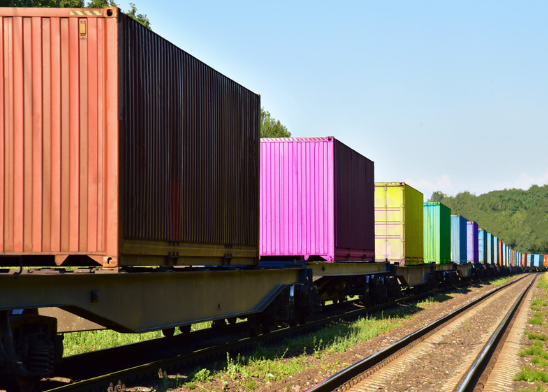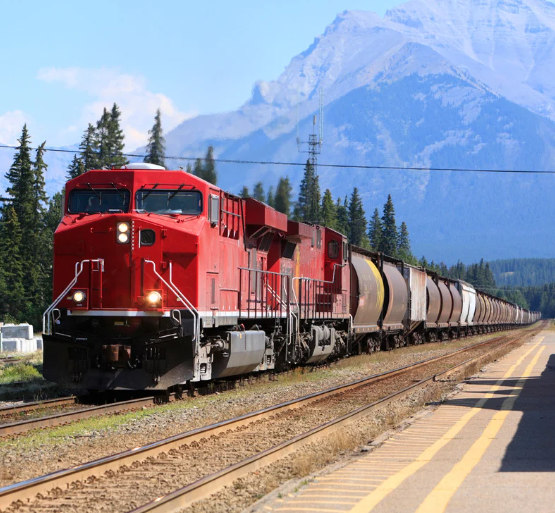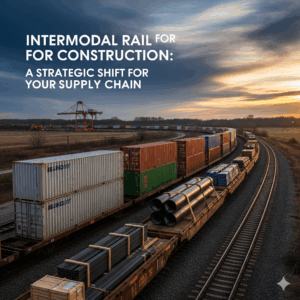Learn the Advantages of Shipping by Rail: Smart, Sustainable, and Cost-Effective Choice for Canadian Freight
In today’s fast-changing logistics world, businesses are under constant pressure to ship smarter, faster, and more sustainably—all while cutting costs and reducing risk. That’s where the advantages of shipping by rail step in as a true game-changer for 2025. Whether you’re a seasoned logistics manager or a business owner exploring new freight options, understanding the core advantages of rail shipping could help you unlock hidden efficiency and profitability within your supply chain.
As e-commerce grows, fuel costs fluctuate, and environmental regulations tighten, rail freight is no longer just an option for big industry players or bulk commodities. It has evolved into a cost-effective, scalable, and environmentally responsible solution for businesses of all sizes. And with the Canadian and U.S. rail infrastructure seeing major investments in intermodal rail corridors, cross-border integration, and carbon-smart innovation, there has never been a better time to explore the real advantages of shipping by rail.
In this comprehensive guide, we’ll walk you through the top five benefits of rail freight, highlight why more Canadian companies are shifting to rail in 2025, and help you determine whether this shipping mode is right for your business.
Why Shipping by Rail Is a Rising Trend in 2025
Let’s begin with the big picture: Rail freight is making a major comeback. With a 2025 market that demands more sustainable and cost-efficient freight options, rail is being recognized as one of the most effective long-haul transportation methods. In fact, some of the most reliable supply chains in Canada now rely on the advantages of shipping by rail to keep goods moving—despite inflation, truck driver shortages, and highway congestion.
Unlike trucking, which is heavily affected by fuel surcharges, cross-border delays, and rising insurance costs, rail shipping offers more stability and resilience. Railways in Canada, such as Canadian National (CN) and Canadian Pacific Kansas City (CPKC), provide access to a vast network of intermodal terminals and Class I freight corridors. These routes are optimized for moving everything from consumer goods and raw materials to refrigerated products and industrial equipment.
Here’s why understanding the advantages of shipping by rail is more than just logistics strategy—it’s a competitive advantage.
1. Cost-Effective Long-Distance Shipping
One of the most well-known advantages of shipping by rail is its cost-effectiveness, particularly for long-distance or cross-country shipments. Trains are incredibly fuel-efficient—moving a ton of freight over 400 miles on a single gallon of fuel. That kind of fuel economy translates into substantial savings, especially when shipping high-volume or heavy freight.
Businesses looking to stabilize their shipping budgets in 2025 are increasingly choosing rail over truckload, especially when freight lanes stretch across provinces or the U.S. border. Unlike over-the-road shipping, which can experience volatile rate increases, rail offers more consistent and predictable pricing. This is particularly useful for companies working on annual or quarterly logistics planning.
By leveraging the advantages of rail shipping, companies can reduce their per-unit transportation costs, protect their margins, and reinvest savings into other growth areas.
2. Sustainability and Environmental Impact
Sustainability is no longer optional—it’s a requirement. Environmental performance now factors into procurement decisions, government tenders, and consumer loyalty. One of the most powerful advantages of shipping by rail is its reduced environmental footprint.
Rail emits up to 75% fewer greenhouse gases per ton-mile compared to truck transport. That makes it one of the greenest modes of freight movement available today. In a regulatory environment where carbon pricing and emissions reporting are becoming more common, this matters.
Companies that shift to rail can dramatically cut their Scope 3 emissions and position themselves as leaders in sustainable logistics. With corporate ESG goals becoming standard, rail provides a clear path to a greener future.
3. Higher Volume and Freight Capacity
Another clear advantage of shipping by rail is its ability to handle massive freight volumes efficiently. One single freight train can carry the load of hundreds of trucks. This makes rail the go-to solution for industries that rely on moving bulk goods, raw materials, or large-scale shipments regularly.
In 2025, with trucking capacity constrained by labor shortages and regulatory limitations, rail provides a much-needed release valve. It’s also a key component in intermodal shipping, where goods are moved via a combination of rail and truck to optimize last-mile delivery.
Rail is ideal for full container load (FCL) shipments, and intermodal systems are becoming increasingly advanced. If your business is growing and needs scalable transportation solutions, the advantages of shipping by rail can help future-proof your supply chain.
4. Safety and Security for Valuable Freight
Shipping goods by rail also provides a significant advantage in terms of safety and cargo security. Rail routes are less susceptible to accidents, weather-related disruptions, and traffic delays. Furthermore, rail terminals are typically more secure than roadside stops, making them less vulnerable to theft and tampering.
This makes rail a preferred method for transporting high-value or sensitive freight, including electronics, machinery, and hazardous materials. In addition, the sealed intermodal containers used in rail shipping reduce the risk of cargo damage due to rough handling or multiple transfers.
With increasing concerns over freight theft and product integrity, especially for long-distance and cross-border shipments, the advantages of shipping by rail offer a compelling solution for Canadian businesses seeking peace of mind.
5. Streamlined Cross-Border and Intermodal Shipping
As North American trade continues to grow, cross-border efficiency becomes a crucial concern for Canadian exporters and U.S.-based importers. The advantages of shipping by rail include seamless connections between Canada and major U.S. markets through integrated rail networks.
Both CN and CPKC offer high-speed, cross-border rail service to U.S. cities like Chicago, Memphis, Kansas City, and beyond. These routes allow for fast, reliable transit while bypassing congested highway crossings. And with customs clearance increasingly integrated into rail operations, businesses benefit from shorter transit times and fewer compliance headaches.
Intermodal rail—where containers are transferred between rail and truck—has expanded rapidly in 2025. This system combines the cost savings of rail with the flexibility of trucking. Intermodal is especially attractive for businesses with centralized warehouses, multiple delivery points, or urban fulfillment centers.
Why Businesses in Canada Are Embracing Rail in 2025
The five core advantages of shipping by rail are driving a transformation in Canadian freight strategy. As companies face pressure to cut costs, meet sustainability goals, and improve shipping resilience, rail is emerging as a top-tier logistics option.
Manufacturers, retailers, agri-businesses, and even small-to-medium enterprises (SMEs) are looking at rail shipping in 2025 not as a fallback, but as a primary mode of freight. With the support of intermodal partners and experienced freight brokers, businesses are discovering that rail isn’t just for mega-corporations—it’s a scalable, accessible, and smart solution.
What to Consider Before You Shift to Rail
Before fully adopting rail into your logistics strategy, consider the following:
- Distance: Rail is best for long-haul and regional freight over 500 km.
- Volume: Larger loads see the greatest cost-per-unit savings.
- Lead Time: Rail is reliable, but not ideal for same-day or express shipments.
- Equipment: Containers and trailers need to be compatible with intermodal systems.
- Support: Partnering with an experienced intermodal provider is key.
With the right planning, the advantages of shipping by rail can transform your business logistics.

Rail Freight Shipping vs Road Freight Shipping
Rail freight and road freight are the two primary modes of overland transportation. While inland shipping can play a supporting role, its limited network of waterways limits its impact compared to all the land-based options.
It’s important to recognize that rail and road transportation are not solely competitors. They can effectively complement each other in intermodal transport concepts. In many cases, road transportation is essential, particularly when destinations are not connected to the rail network or when the rail system is overwhelmed.
This highlights one of the limitations of rail freight. But dont worry In the following sections, we will go deeper into the advantages of rail transport. We will not only be focusing on its environmental benefits but also be considering factors that influence the decision-making process for selecting the most suitable mode of transportation.
Advantages of Shipping by Rail
The most popular advantages of shipping by rail are:
Environmental Sustainability
Rail transport is a highly sustainable mode of transportation, with a significantly lower carbon footprint compared to road transport, this is one of the advantages of shipping by rail. In Europe, a large portion of freight trains operate on electric power, further reducing greenhouse gas emissions. As the use of green electricity increases, rail freight could potentially achieve net-zero emissions.
Efficiency and Capacity
Rail freight offers several efficiency advantages of shipping by rail. Trains can transport larger and heavier loads than trucks, making them particularly efficient for long-distance routes. Block train transport, where trains carry a single, large load without splitting up en route, further enhances efficiency. Additionally, rail freight can accommodate both full container loads (FCL) and less-than-container loads (LCL), providing flexibility for various shipment sizes.

Safety and Security
Rail transport is significantly safer than road transport, with a much lower risk of accidents and cargo theft. The robust infrastructure and controlled environment of rail lines significantly contribute to the advantages of shipping by rail and a more secure transportation experience.
Reliability and Predictability
While construction sites and unforeseen incidents can occur on any mode of transportation, rail transport offers greater predictability due to its regulated timetables. This minimizes the risk of short-term delays caused by traffic congestion.
Intermodality
Rail freight’s compatibility with standardized containers and trailers allows for seamless integration with road transport. This intermodal capability highlights advantages of shipping by rail and eliminates the need for time-consuming reloading and provides flexibility in transportation options.
Additional Considerations for Rail Shipping are
While the advantages are very incentivizing, some things to consider are –
- Infrastructure: The availability and condition of rail infrastructure can impact the efficiency and cost-effectiveness of rail freight. Investing in upgrades and maintenance is crucial for maximizing its benefits.
- Route Network: The extent and connectivity of rail networks can limit the reach of rail freight. Expanding the network and improving access to key regions can enhance its attractiveness to businesses.
- Cost: While rail freight can be cost-effective for long-distance transportation of large volumes, factors such as infrastructure costs, fuel prices, and labor costs can influence overall costs.
- Lead Times: Rail freight may have longer lead times compared to road transport, especially for shorter distances. Businesses should carefully consider their specific needs and time constraints.
Conclusion: Why the Advantages of Shipping by Rail Matter More Than Ever in 2025
In a freight market where margins are tighter, demand is higher, and the pressure to go greener is growing by the day, the advantages of shipping by rail stand out as not just a smart logistics strategy—but a competitive necessity. As we wrap up this 2025 ultimate guide, let’s revisit why rail transportation continues to be one of the most powerful freight options for businesses across Canada and North America.
The Advantages of Shipping by Rail Are Built for the Future
In 2025, shipping by rail isn’t just a legacy solution—it’s a future-forward freight strategy designed for resilience, scalability, and sustainability. The advantages of shipping by rail touch every key part of your logistics strategy, from cost control to carbon reduction, capacity optimization, and cross-border agility.
Whether you’re shipping bulk commodities, pallets of consumer goods, or containerized freight in intermodal service, here’s why more businesses are making rail part of their supply chain transformation this year:
- Lower fuel costs and more predictable pricing than trucking
- Greater freight capacity for high-volume, long-distance routes
- Reduced emissions for stronger ESG performance and brand reputation
- Consistent transit schedules with fewer highway disruptions
- High security and lower theft risk, especially for high-value cargo
Let’s break these down one more time, and explore how each of these advantages of shipping by rail gives your business a smarter edge.
1. Lower Transportation Costs Without Sacrificing Reliability
For many Canadian shippers, controlling freight costs is priority number one—and one of the biggest advantages of shipping by rail is cost-efficiency. With fuel prices remaining volatile and highway tolls rising, rail delivers a price advantage, especially on long-haul routes.
Rail’s energy efficiency is unmatched. Freight trains can move a ton of cargo over 400 miles on just one gallon of fuel. That translates into lower fuel surcharges and more predictable pricing—benefits that help stabilize your logistics budget.
Moreover, rail is less subject to the driver shortages plaguing the trucking industry, which means fewer unexpected rate hikes and scheduling disruptions.
2. Environmental Benefits That Align with ESG Goals
More than ever, businesses are expected to measure and reduce their carbon footprint. Whether driven by internal sustainability goals, customer expectations, or regulatory pressures, environmental accountability is a major factor in shipping decisions.
And this is where another major advantage of shipping by rail comes in: green freight.
Compared to trucks, trains produce up to 75% fewer greenhouse gas emissions per ton-mile. That’s a huge win for companies looking to align their logistics operations with environmental, social, and governance (ESG) standards. Rail shipping helps companies earn carbon credits, meet climate disclosure requirements, and demonstrate commitment to sustainability in their public reporting.
3. Freight Capacity Built for Scaling
With the rise of e-commerce, B2B demand, and supply chain decentralization, freight volume is exploding. If your business is scaling and needs to move more cargo, more frequently—rail is your ally.
Trains can move hundreds of containers in a single trip. Unlike truck fleets limited by the number of available drivers, trains are built to handle surges in freight demand. That means the advantages of shipping by rail include higher-volume capabilities, especially for seasonal or bulk shipments.
When paired with intermodal service (rail plus truck), you get the best of both worlds: long-distance efficiency with flexible last-mile delivery.
4. Safer, More Secure Freight Movement
Railroads operate on dedicated tracks, meaning fewer risks of accidents, congestion, or theft—especially compared to highways. This makes another powerful advantage of shipping by rail: security.
For shippers of high-value, fragile, or temperature-sensitive goods, rail is a lower-risk mode. Intermodal containers are sealed, tracked, and handled with minimal interference, reducing damage claims and losses.
In fact, rail has some of the lowest cargo theft rates in the logistics industry—something supply chain professionals are increasingly concerned about in 2025.
5. Rail Supports Cross-Border and Intermodal Efficiency
If you’re shipping between Canada and the U.S., the advantages of shipping by rail extend across the border. Canadian National (CN) and Canadian Pacific Kansas City (CPKC) offer seamless north-south connections into major U.S. hubs, including Chicago, Detroit, Dallas, and beyond.
Cross-border rail simplifies customs clearance, consolidates documentation, and improves compliance—all while avoiding congested highway border crossings. And with rising demand for intermodal shipping, combining rail with drayage (short-distance trucking) creates a streamlined, scalable supply chain solution.
You can move full container loads (FCL), pallets, or consolidated shipments with ease—maximizing efficiency across every stage of the freight journey.
Rail = Long-Term Supply Chain Resilience
Perhaps the most overlooked advantage of shipping by rail is long-term resilience. In an era marked by supply chain disruptions, port congestion, weather events, and driver shortages, rail provides stability.
Railways invest heavily in infrastructure, automation, and maintenance—ensuring consistent performance even during turbulent times. As Canada and the U.S. continue to prioritize rail modernization, shippers who invest in rail now will be better positioned for long-term cost savings and agility.
When to Choose Rail Over Other Shipping Modes
Rail isn’t always the perfect fit—but when it is, the value is undeniable. The advantages of shipping by rail shine brightest when:
- You’re moving freight over long distances (500+ km)
- You have high-volume or consistent freight needs
- Your cargo is heavy, non-perishable, or containerized
- You want to reduce emissions and boost ESG reporting
- You’re shipping cross-border and want to avoid highway delays
- You’re open to intermodal solutions for cost and flexibility
If this sounds like your business model, it’s time to explore rail in greater depth.
How RailGateway Helps You Unlock the Advantages of Shipping by Rail
At RailGateway, we specialize in helping Canadian businesses unlock all the advantages of shipping by rail—without the headaches or confusion. Whether you’re new to rail shipping or ready to scale your intermodal freight operations, we make the process easy, efficient, and results-driven.
Here’s how we help you win with rail:
✅ Cost-Effective Intermodal Solutions – We combine rail and truck for maximum efficiency at competitive rates.
✅ Route Optimization – We map the best lanes across Canada and into the U.S. for your shipping needs.
✅ Documentation & Customs Support – We handle all paperwork and customs clearances to avoid delays.
✅ Freight Consolidation – Need to combine small shipments into full containers? We’ve got you covered.
✅ Dedicated Customer Service – Our experts are available to guide you at every step—from quoting to delivery.
✅ Real-Time Tracking – Stay in control of your shipments with live status updates and proactive alerts.
With over 40 years of experience in Canadian rail logistics, we know what it takes to ship smarter. We understand the real-world challenges you face and offer practical, tailored solutions that help you reduce costs, boost efficiency, and achieve your logistics goals.
Ready to Embrace the Advantages of Shipping by Rail?
2025 is the year to reimagine your freight strategy. If you’re tired of volatile trucking costs, capacity shortages, and growing pressure to reduce emissions—rail is your answer.
Discover how the advantages of shipping by rail can transform your logistics performance. From sustainability and scalability to savings and security, RailGateway is here to deliver the rail advantage to your business.
📦 Visit RailGateway.ca to request a free quote, explore service options, and take the first step toward smarter, more resilient freight in 2025.
Let us help you move your business forward—one container, one railcar, one smarter shipment at a time.

FAQ’s
What Are The Benefits Of Rail Shipping?
High-speed rail shipping offers several significant benefits. It reduces travel times, promotes economic growth and development in nearby regions, and contributes to a cleaner environment by reducing emissions.





